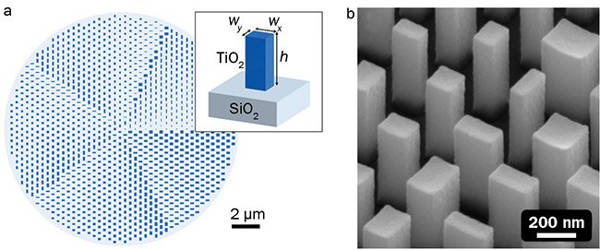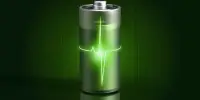Much of today’s technology relies on the ability to precisely control the various properties of laser light, from commercial virtual reality (VR) headsets to microscopic imaging for biomedical research. Many modern laser systems rely on separate, rotating components to control the wavelength, shape, and power of a laser beam, making them bulky and difficult to maintain.
Harvard John A. Paulson School of Engineering and Applied Sciences researchers have created a single metasurface that can effectively tune the different properties of laser light, including wavelength, without the use of additional optical components. The metasurface has the ability to split light into multiple beams and control their shape and intensity independently, precisely, and efficiently.
The findings pave the way for lightweight and efficient optical systems in a variety of applications ranging from quantum sensing to VR/AR headsets.
Researchers have developed a single metasurface that can effectively tune the different properties of laser light, including wavelength, without the need for additional optical components.
“Our approach paves the way for new methods to engineer the emission of optical sources and control multiple functions, such as focusing, holograms, polarization, and beam shaping, in parallel in a single metasurface,” said Federico Capasso, the paper’s senior author and the Robert L. Wallace Professor of Applied Physics and Vinton Hayes Senior Research Fellow in Electrical Engineering at SEAS.
The findings were recently published in Nature Communications.
The tunable laser is made up of only two parts: a laser diode and a reflective metasurface. Unlike previous metasurfaces, which relied on a network of individual pillars to control light, this surface employs supercells, which are groups of pillars that collaborate to control different aspects of light.
When light from the diode strikes the supercells on the metasurface, some of it is reflected back, resulting in the formation of a laser cavity between the diode and the metasurface. The other half of the light is reflected into a separate beam from the first.

“When light hits the metasurface, different colors are reflected in different directions,” said Christina Spägele, the paper’s first author and a graduate student at SEAS. “We were able to harness this effect and design it so that only the wavelength we chose has the correct direction to enter back into the diode, allowing the laser to operate only at that wavelength.”
The researchers simply move the metasurface in relation to the laser diode to change the wavelength.
“Because there is no rotating component, the design is more compact and simpler than existing wavelength-tunable lasers,” said Michele Tamagnone, a former postdoctoral fellow at SEAS and co-author of the paper.
The researchers also demonstrated that the laser beam’s shape can be fully controlled in order to project a complex hologram—in this case, the complex, century-old Harvard shield. The team also demonstrated the ability to split incident light into three independent beams, each with its own set of properties: a conventional beam, an optical vortex, and a Bessel beam, which looks like a bullseye and is used in a variety of applications, including optical tweezing.
“This ability to generate multiple beams in parallel and directed at arbitrary angles, each implementing a different function, will enable many applications ranging from scientific instrumentation to augmented or virtual reality and holography,” said Capasso.
“Our approach paves the way for new ways of designing light source radiation and simultaneously controlling multiple functions such as focusing, holograms, polarization, and beam shaping on a single metasurface,” he said. Federico Capasso, a representative for Robert L. Wallace, stated. Vinton Hayes, a professor of applied physics and a senior researcher in electrical engineering at SEAS, is a senior author of the treatise.
















